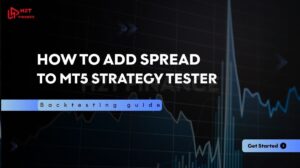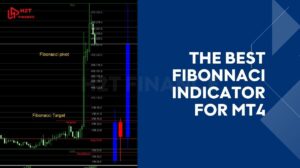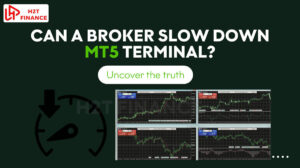The forex market, a dynamic powerhouse of the global economy, drives the exchange of currencies and fuels international trade. With a daily trading volume exceeding $7.5 trillion, it’s the largest financial market worldwide, offering unparalleled opportunities for traders. Whether you're a beginner or seasoned investor, understanding how the forex market works unlocks the potential to profit from currency fluctuations, manage risks, and diversify your portfolio.
This vibrant market operates 24 hours a day, five days a week, allowing traders to react instantly to global events. From individuals seeking financial growth to corporations hedging risks, the forex Market caters to all. Ready to explore this exciting world? Dive into our guide to discover how you can start your journey with confidence and clarity.
Key takeaways
- The forex market is the largest financial market in the world, where currencies are traded in pairs with a daily trading volume exceeding 7.5 trillion dollars.
- Forex trading is based on the exchange rate fluctuations between two currencies in a pair, consisting of the base currency and the quote currency.
- Forex prices are represented by the bid (buy) and ask (sell) prices, with the spread being the transaction cost traders must pay.
- A pip is the smallest unit used to measure price movement, usually the fourth decimal place in the exchange rate, while a lot is the standard unit used to define the trading volume.
- The market operates continuously 24 hours a day, 5 days a week, with many participants including central banks, commercial banks, hedge funds, multinational corporations, and individual traders.
- Key factors influencing currency fluctuations include monetary policy, economic news, market sentiment, political events, and commodity prices.
- Leverage helps increase position control with small capital but also raises risk; effective risk management is a critical factor for success.
- Beginners should start with simple strategies like trend following, range trading, and breakout trading, while practicing on demo accounts to minimize risk.
- Avoid common mistakes such as using excessive leverage, not setting stop-loss orders, and trading based on emotions to protect capital and maintain long-term stability.
- Using supporting tools like trading platforms (MetaTrader 4, TradingView), economic calendars, and online learning resources can help improve trading efficiency.
1. Basic things to know about the forex market
To get started with forex, you need to understand some fundamental concepts. These are the building blocks that help you grasp how the market operates and how to determine trade values.
- What is forex? Forex (Foreign exchange) is the global market where currencies are bought and sold in pairs. Traders earn profits based on the exchange rate changes between two currencies.
- Currency pair: Every forex trade involves two currencies, called a currency pair, for example: EUR/USD, USD/JPY, or GBP/USD. The first currency is the base currency, and the second is the quote currency.
- Base currency and quote currency: The base currency always has a value of one unit. The quote currency shows how many units are needed to buy one unit of the base currency. For example, if EUR/USD = 1.10, it means 1 EUR equals 1.10 USD.
- Spread: This is the difference between the bid price (buy) and the ask price (sell) of a currency pair. The spread is a type of transaction cost that traders pay to the broker.
- Pip: A pip (Percentage in Point) is the smallest unit of price movement in an exchange rate, usually found at the fourth decimal place of a currency pair. For pairs involving JPY, the pip is measured at the second decimal place. Additionally, a pipette represents the change at the fifth decimal place (or third for JPY pairs).
- Lot: A lot is the standard trading unit in forex. One standard lot equals 100,000 units of the base currency, a mini lot is 10,000, and a micro lot is 1,000. The larger the lot size, the higher the value of each pip.
2. How the forex market works?
With a daily trading volume surpassing $7.5 trillion, the forex market is a hub of liquidity and opportunity. Understanding how does the forex market work is key to navigating its fast-paced environment, whether you aim to buy a currency pair for potential gains or sell a currency pair to capitalize on price shifts.
At its core, forex trading revolves around currency pairs, such as EUR/USD (Euro vs. US Dollar) or AUD/USD (Australian Dollar vs. US Dollar). These pairs are categorized as major (e.g., EUR/USD, highly liquid), minor (e.g., EUR/GBP, no USD), or exotic (e.g., USD/THB, involving emerging economies).

When you buy a currency pair, you’re betting the base currency (e.g., EUR) will strengthen against the quote currency (e.g., USD). Conversely, to sell a currency pair, you anticipate the base currency will weaken.
Prices in the forex Market are determined by the bid (the price to sell) and ask (the price to buy), with the difference, or spread, representing the trading cost. Major pairs typically have tighter spreads due to high liquidity, while exotic pairs may have wider spreads. This decentralized market, driven by banks, brokers, and traders, thrives on real-time price movements influenced by global events, making it essential to grasp how the forex market works for successful trading.
3. What influences the foreign exchange market?
The forex market is shaped by a variety of participants and factors, each contributing to price fluctuations and market liquidity. Key influences include:
- Central banks: Institutions such as the U.S. Federal Reserve (Fed) or the European Central Bank (ECB) control monetary policy, adjust interest rates, and occasionally intervene directly in the market. For example, when the Fed raises interest rates, the U.S. dollar often strengthens, significantly impacting pairs like EUR/USD.
- Commercial banks: These institutions handle massive daily transaction volumes, serving client needs while also engaging in speculative trading for profit. Such activities can amplify price volatility, especially during the release of major economic news.
- Hedge funds and institutional investors: Operating with large-scale trades and complex strategies, they exploit market movements to seek profits. Their actions can cause sharp exchange rate changes in a short period, particularly during times of high market volatility.
- Multinational corporations: Large companies participate in forex to hedge against exchange rate risks in international transactions. This helps them stabilize finances but also affects the supply and demand for certain currencies.
- Retail traders: Individuals trading through online platforms contribute to market liquidity. When many traders focus on the same pair such as AUD/USD price trends can be influenced.
- Economic and political news: Economic reports, employment data, interest rate decisions, or major political events can cause rapid currency price swings. Positive news often boosts demand for the currency of the related region, while negative news can weaken it.
- Market sentiment: Trader expectations and overall market outlook can drive movements on their own. If the majority believe a currency will rise, mass buying can push its price higher and vice versa.
4. Factors driving currency prices
The factors influencing currency prices create the dynamic fluctuations traders navigate in the forex market. From economic indicators to political events, these elements shape currency values, offering opportunities and risks for traders.
Economic indicators, such as interest rates, GDP growth, and inflation, are primary drivers. For instance, when the Reserve Bank of Australia raises interest rates, the AUD often strengthens in pairs like AUD/USD, reflecting increased investor confidence. Strong GDP or low unemployment data can similarly boost a currency’s value, while high inflation may weaken it. These factors influencing currency prices provide critical insights for traders.
Political stability also plays a key role. Stable governments attract foreign investment, strengthening currencies, whereas political turmoil, like Brexit’s impact on GBP, can trigger sharp declines. Market sentiment further influences prices, with traders flocking to safe-haven currencies like JPY or CHF during global uncertainty, driving rapid currency price movements.
Commodity prices, particularly for resource-rich nations like Australia, are another factor. Rising commodity prices often bolster the AUD in AUD/USD, showcasing how external markets affect forex. By understanding these economic indicators and other drivers, traders can better predict and respond to factors influencing currency prices.
5. Leverage and risk management in forex
Leverage in forex trading allows traders to control large positions with minimal capital, amplifying both profits and risks. Understanding how to use leverage wisely, paired with effective risk management techniques, is crucial for success in the forex market.
With leverage in forex trading, a trader can control a $100,000 position with just $1,000 using a 100:1 ratio. This magnifies gains when you buy or sell a currency pair, but losses can exceed your initial investment if the market moves against you. For example, a 1% drop in a $100,000 position could wipe out your $1,000 capital, highlighting the need for caution.
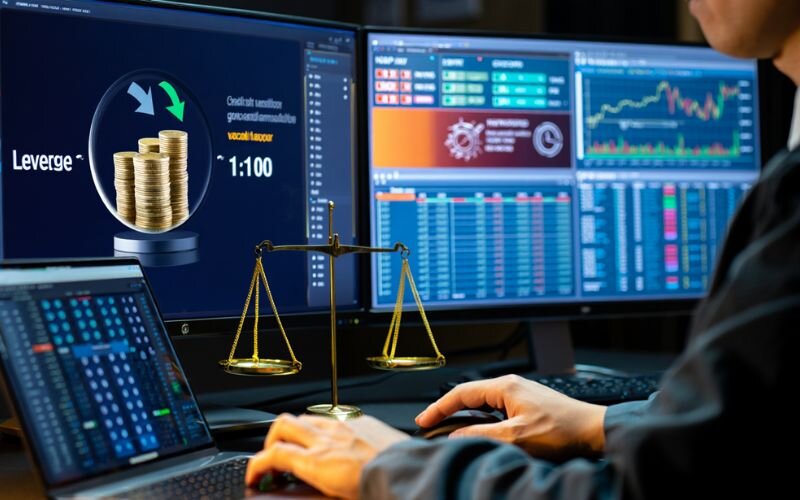
Risk management techniques like stop-loss orders protect your capital by automatically closing trades at a set price, limiting losses. Position sizing, another key strategy, ensures you risk only 1-2% of your account per trade. For instance, trading AUD/USD with proper sizing prevents devastating losses during volatile market swings.
By mastering leverage in forex trading and applying disciplined risk management techniques, traders can navigate the market’s volatility with greater confidence and protect their capital for long-term success.
6. Beginner-friendly forex trading strategies
Forex trading strategies for beginners provide a clear path to navigate the complex forex market with confidence. By mastering simple approaches, new traders can trade forex effectively, minimizing risks while building skills.
Trend following is a popular strategy, where traders identify market directions using tools like moving averages. For example, if EUR/USD consistently rises above its 50-day moving average, it signals a bullish trend, prompting traders to buy. Range trading suits stable markets, where traders buy at support levels and sell at resistance levels, such as when AUD/USD fluctuates within a predictable range. Breakout trading involves entering trades when prices break key levels, like a surge in GBP/USD after breaching resistance, often leading to significant gains.
Practicing these forex trading strategies for beginners on a demo account is invaluable. Platforms like MetaTrader 4 allow you to trade forex in a risk-free environment, testing strategies without financial loss. This hands-on practice builds confidence and refines your approach, preparing you for real-market conditions.
By starting with these straightforward strategies and leveraging demo accounts, beginners can develop the skills needed to trade forex successfully and grow in the dynamic Forex market.
7. Common mistakes to avoid
Avoiding common mistakes in Forex trading is essential to protect your capital and build a foundation for long-term success. Below are typical errors along with important notes:
Overusing leverage: Many new traders are attracted to high leverage, such as 100:1, because it allows controlling large positions with a small amount of capital. However, a small 1% price movement can wipe out your entire investment.
⭢ Note: Use leverage appropriate to your risk tolerance and experience to avoid severe losses.
Ignoring risk management: Failing to set stop-loss orders or risking more than 1-2% of your account per trade is a common mistake that leads to significant losses.
⭢ Note: Always use stop-loss orders to limit losses and determine position size according to your acceptable risk level.
Trading based on emotions: Greed, fear, or excessive hope can cause irrational decisions, such as holding onto losing trades for a long time hoping for a reversal.
⭢ Note: Maintain a calm mindset, follow your trading plan, and avoid impulsive decisions driven by temporary emotions.
Lack of discipline in trading: Not adhering to rules like cutting losses or lacking a clear plan makes managing capital and profit opportunities difficult.
⭢ Note: Develop and strictly follow a trading strategy, keep a trading journal to learn from your experience, and control your behavior.
By recognizing and steering clear of these mistakes, you will build a solid foundation and increase your chances of successful trading in the Forex market.
8. Essential tools and resources for forex success
Mastering the Forex market requires the right forex trading tools and resources to learn forex trading effectively. These tools and platforms empower beginners to analyze markets, practice strategies, and stay informed, setting the stage for success.
Forex trading tools like MetaTrader 4 and TradingView offer powerful charting capabilities, enabling traders to track price trends and identify entry points for pairs like EUR/USD or AUD/USD. Mobile apps from brokers allow you to monitor trades and react to market shifts on the go, leveraging the market’s 24/5 availability. Economic calendars, such as those on Forex Factory, provide real-time updates on economic indicators that drive currency prices.
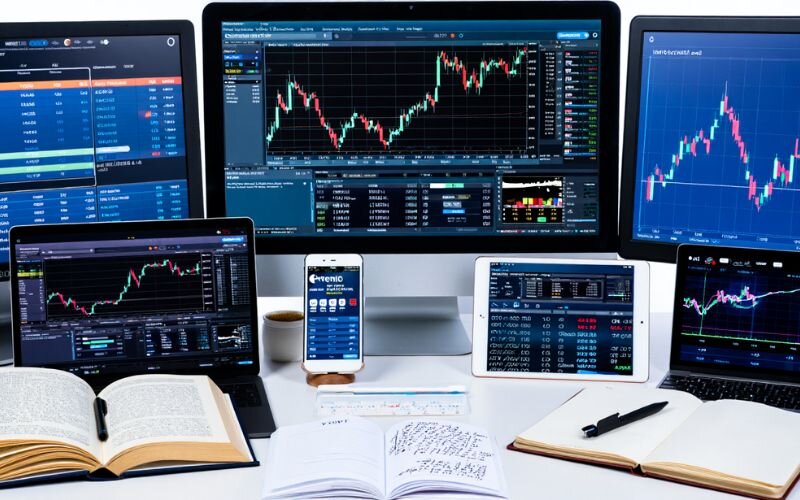
To learn forex trading, platforms like Babypips offer beginner-friendly courses, covering everything from currency pairs to risk management. Joining communities on Reddit or Forex Peace Army connects you with experienced traders for insights and support. Demo accounts, available on most trading platforms, let you practice strategies risk-free, building confidence before trading real capital.
By leveraging these forex trading tools and resources, you can deepen your understanding and learn forex trading with practical, hands-on experience, paving the way for informed and profitable trades.
9. Frequently asked questions (FAQs)
9.1. What’s the minimum amount to start trading forex?
You can begin with $50-$100, but $500-$1,000 allows better risk management. Micro-lots make trading accessible for beginners.
9.2. How do I know when to buy or sell a currency pair?
Use technical analysis (e.g., moving averages) and fundamental analysis (e.g., interest rates) to identify entry and exit points.
9.3. Is forex trading risky?
Yes, but risk management techniques like stop-loss orders and position sizing minimize losses, ensuring sustainable trading.
Read more:
- What is a binary option? How they work & key risks
- How to Use Fibonacci Retracement: A Practical Guide for Traders
10. Conclusion
Mastering the forex market is a rewarding journey that begins with understanding how the forex market works. From currency pairs to risk management, the knowledge shared in H2T Finance's Forex Basics guide equips you to navigate this dynamic market with confidence. Whether trading EUR/USD or AUD/USD, success hinges on continuous learning and disciplined strategies.
